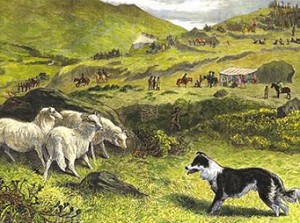In the Eyes of the Artist – The Border Collie
264 – July, 2017
text and illustrations by Ria Hörter
 Fourteenth-century engravers, 18th-century painters and yesterday’s photographers all show us dogs as seen through their eyes. Their work is an enlightening way to follow the development of breeds and how they were seen in the eyes of the artist.
Fourteenth-century engravers, 18th-century painters and yesterday’s photographers all show us dogs as seen through their eyes. Their work is an enlightening way to follow the development of breeds and how they were seen in the eyes of the artist.
THE BORDER COLLIE
Perpetual Motion
At the end of the 16th century, Dr. John Caius described in Treatise on Englishe Dogges the working style of various sheepdogs. Their style of driving sheep was more or less the same as that of today’s working Border Collies. With hand signals and a shrill whistle, the shepherd directed his dog to where he wanted his flock to go.
In both the 20th and 21st centuries, many breeds became unemployed, but in Britain – from the Borders between England and Scotland to the Hebrides – people can still enjoy the sight of large flocks of sheep driven by Border Collies. Upwards and downwards, over the hilltops, down again, to the farm and the sheep fold. Perpetual motion through the ages…
British Artists
At the beginning of the 19th century, England had many different sheepdogs, not only Border collies, but also Scotch collies, Highland collies, Old Welsh Grey sheepdogs, Smithfield sheepdogs, Welsh hillmen, Cumberland sheepdogs, Dorset blues, Welsh black-and-tan sheepdogs, bobtailed sheepdogs, etc. From the mid-19th century, an abundance of different sheepdog types was used by farmers to drive their cattle and sheep. One of these types that is still known today – the Border collie – derives its name from the Borders and from a black-headed sheep with black legs: the coalley or black-faced sheep. According to the Agricul- tural Dictionary (1743), the dogs that drove and tended the flocks were called coalleys- dogs or coally-dogs.
Smooth-Coated Colley
Many dog books from the mid-19th century contain breed descriptions, but it has to be said that the authors frequently quoted each other and re-used illustrations.
Old British dog books are illustrated with engravings, drawings and paintings by some of the best English artists who made true-to- nature images of many breeds, including sheepdog breeds.
In 1800, Thomas Bewick wrote about the shepherd dog in his A General History of Quadrupeds: “This useful animal, ever faithful to his charge, reigns at the head of the flock; where he is better heard, and more attended to, than even the voice of the shepherd. Safety, order, and discipline are the fruits of his vigilance and activity.”
Published between 1830 and 1840, the Naturalist’s Library, edited by Scottish naturalist Sir William Jardine, includes an engraving titled The Shepherd’s, or Sheepdog. The dog has a tricolor coat, half-erect ears and is slightly higher on leg than today’s Border Collie.
In William Youatt’s The Dog, published in 1845, only two small drawings support the text. Youatt used the word “sheep-dog” when writing about the shepherd’s dog, saying “colley” was the Highland term. Two drawings show us a Scotch Sheep-Dog and an English Sheep-Dog.
The colley described in Hugh Dalziel’s British Dogs (1881) is illustrated with engravings of a rough-coated colley and a smooth-coated colley.
Click here to read the complete article264 – July, 2017

Short URL: http://caninechronicle.com/?p=128704
Comments are closed











